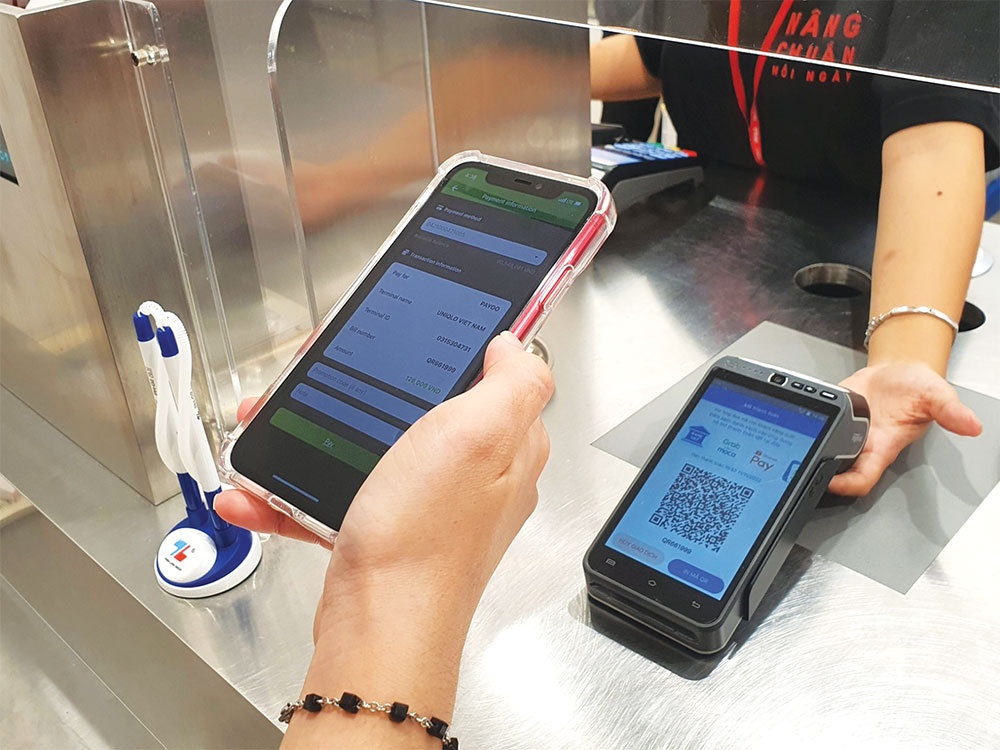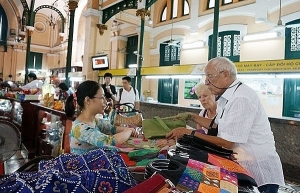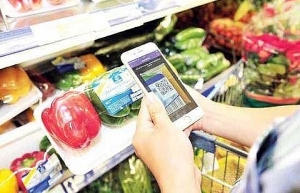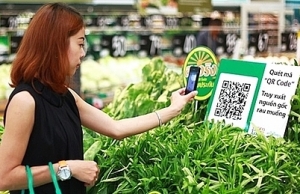QR codes pushing development in digital payments
Vietnamese people like Nguyen Viet Hoan, a freshman at FPT University in Hanoi, no longer continues to keep too much cash in their wallets. Hoan now mostly scans QR codes to pay for all daily services such as haircuts, paying for meals, parking, or shopping.
“Almost all the shops near me, whether popular stores on the street or luxury stores in shopping malls, provide additional payment solutions with QR codes,” Hoan said. “With just a few simple steps, the transaction has been successfully completed. I no longer have to carry cash every time I go out, reducing the risk of losing money. It also limits the situation of transferring to the wrong account number.”
 |
| There has been an explosion this year in the number of stores and outlets that utilise QR codes here |
Although appearing many years ago, payments by QR code have only become more popular in recent months in Vietnam, when it began to penetrate more popular businesses. This change is partly the result of the government’s efforts to promote digital transformation and cashless payments over the past two years, partly due to changes in consumers’ shopping habits.
QR payment methods are often prevailing over other non-cash payment methods such as e-wallets, bank transfers, and bank cards. According to a recent report released by the State Bank of Vietnam, QR code payments increased by 56.5 per cent in quantity and 111.6 per cent in value as of late Q3, as compared to the figures of the same period in 2021; the total number of activated e-wallets climbed by 10.37 per cent as compared to that of the end of 2021.
According to the latest statistics by the end of the third quarter of 2022 on Payoo, including transactions through its payment gateway and over-the-counter payment via Payoo POS, QR codes also recorded impressive growth, with an increase of 62 per cent in quantity and 53 per cent in value compared to the second quarter of 2022.
Statistics have indicated that the groups with the strongest growth rate of QR payments are supermarkets, convenience stores, food and beverage (F&B) groups, and technology groups. Supermarkets increased 68 per cent in volume and 45 per cent in value compared to the second quarter. Particularly, the F&B group rose by 79 per cent in quantity and 90 per cent in value.
QR payment in the technology segment in the quarter made a breakthrough, with the transaction value doubling in the group of phones and laptops, and expanding by half in the group of products related to electronics.
In fashion and accessories, this form of payment also recorded an average growth of nearly 50 per cent in both quantity and value. The growth of the fashion industry group is thanks to the active organisation of promotions from businesses to stimulate users to experience QR code payments.
Ngo Trung Linh, general director of VietUnion, the owner of Payoo, said, “In Vietnam, QR payments are receiving the support of the whole of society. Banks and fintech organisations in the market have potential and are actively participating in market expansion and increasing payment acceptance points. Most of the customers using the service are modern users who are more adaptable and easily accept new things.”
Linh said that due to low investment costs and quick implementation, QR has quickly occupied a certain position in the payment market, and this success can be most clearly seen in China, where it has gradually replaced most traditional payment methods.
Currently, Wechat from Tencent Group and Alipay from Alibaba are dominating the e-payment market share in China with 39 and 55 per cent respectively. In total, these two tech giants control more than 90 per cent of China’s mobile-payment market, worth an estimated $47.5 trillion in 2021.
Realising the growth potential of QR payments in society, many fintech companies and payment intermediaries are also developing new payment solutions based on the technology, simplifying the process and optimising operations and especially reducing transaction processing costs, which is a headache for many businesses.
In September, Dragon Capital launched a feature to support investors to pay for fund certificates investment on the DragonX digital platform by QR code in both website and app versions. This feature allows users to simply place an order on Dragon X, then open the mobile banking application of the bank they are using, and upload a screenshot of the QR code to make a payment.
 | Tourists can learn about HCMC with QR codes Tourists visiting HCMC from November can scan a quick response code (QR code) to gain all information, images and videos about tourist attractions such as the Central Post Office, Saigon Opera House and Ben Thanh Market in the city. |
 | Hanoi eyes QR codes to trace food The capital city has granted management account codes to nearly 2,000 agricultural product enterprises to boost the use of QR codes to trace product origins. |
 | Nearly 6,000 agricultural products granted traceability codes The Department of Agriculture and Rural Development of Hanoi has so far managed and granted administrative account codes for 2,527 for facilities, cooperatives, businesses and shops which trade safe food, agro, forestry and fishery products in the capital city. |
 | QR codes being installed around Ly Son Island The installation of QR codes at tourism sites in Ly Son island district in central Quang Ngai province is being carried out by the management board of the Ly Son-Sa Huynh Geo-Park in coordination with district authorities, as part of efforts to promote digitalisation in the tourism sector. |
What the stars mean:
★ Poor ★ ★ Promising ★★★ Good ★★★★ Very good ★★★★★ Exceptional
 Tag:
Tag:
Themes: Digital Transformation
Related Contents
Latest News
More News
- Mondelez Kinh Do - a chapter of purpose-led leadership in Vietnam (December 18, 2025 | 09:44)
- VNPAY services receive the highest-level PCI DSS international security certificates for six consecutive years (December 17, 2025 | 23:47)
- PPL extends its reach into ASEAN (December 17, 2025 | 15:44)
- Over 600 BUV graduates meeting quality benchmarks across triple quality assurance levels (December 17, 2025 | 13:00)
- HEINEKEN Vietnam partners with Ho Chi Minh City Traffic Police on road safety drive (December 17, 2025 | 09:42)
- BUV and China’s CSCSE sign MoU to boost educational cooperation (December 17, 2025 | 08:00)
- PVT Logistics honoured with ‘Fast Enterprise Award’ at APEA 2025 (December 16, 2025 | 18:22)
- Empowering Sustainable Data Centers with Smart Infrastructure Solutions (December 16, 2025 | 13:59)
- Vietjet wins gold ESG transport sustainability award in Taiwan (China) (December 13, 2025 | 22:03)
- Legal framework completed for national digital transformation (December 13, 2025 | 21:55)
























 Mobile Version
Mobile Version